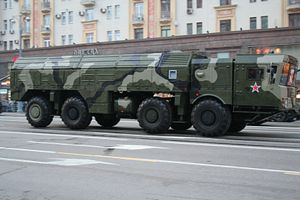All missile units of the Russian Ground Forces are expected to be retrofitted with short-range nuclear-capable road-mobile 9K720 Iskander-M (NATO reporting name SS-26 Stone) ballistic missile system by the end of 2020, Russia’s Minister of Defense, Sergei Shoigu, told the upper house of the Russian parliament on May 24.
“As for the general-purpose forces, self-sufficient groupings of troops and forces capable of adequately responding to any military security threats will be established in all the strategic directions, including the Arctic, by late 2020,” Shoigu said Wednesday, according to TASS news agency. “The Army is expected to have been fully rearmed with modern Iskander-M missile systems by that time.”
Shoigu’s statement appears to contradict earlier reports by senior Russian military officers that the switch to the Iskander-M ballistic missile would be completed by the end of 2017. “We’ll complete the rearmament and the switchover to Iskander complexes across the country this year,” the commanding officer of the Russian Ground Forces, Colonel-General Oleg Salyukov, said on February 22.
The Iskander-M was specifically designed to replace the Soviet-era OTR-21 tactical missile which was eliminated by the INF treaty. As I noted in 2016:
The Iskander-M missile [9M723] purportedly was inducted into service already in 2006. Rumors emerged in March and April 2016 that the missile had been deployed to Syria. The missile was also publicly displayed during this year’s May 9 Victory Day parade.
The two-stage solid propellant missile allegedly has a range of 400-500 kilometers (310 miles) and its [nuclear-capable] single warhead can carry a payload of about 700 kilograms. It has been specifically designed to evade Western missile defenses and reportedly is able to operate in temperatures ranging from -50 to 50 degrees Celsius (-58 to 122 degrees Fahrenheit).
Earlier this year, I explained:
The tactical ballistic missile can be deployed to destroy a host of different targets including missile and multiple launch rocket systems, artillery batteries, as well as command posts and communications centers. It can be armed with variety of different warheads for that purpose. The total number of 9K720 Iskander-M missile systems currently deployed in the RGF is estimated to be over 100. A shorter-range export variant of the 9K720 Iskander-M missile system has been offered to China, India, and South Korea. However, only the domestic version of the missile can be armed with a nuclear warhead.
One of the last test firings of the missile occurred in August 2016. In February 2017, the Russian military purportedly fired four Iskander-M ballistic missiles against targets in Syria’s Idlib province.

































